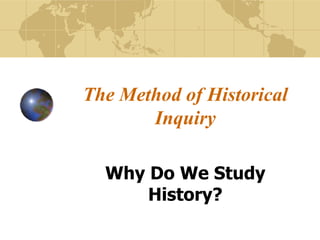Whyhistory
•Descargar como PPTX, PDF•
0 recomendaciones•538 vistas
Why study his
Denunciar
Compartir
Denunciar
Compartir

Más contenido relacionado
Destacado (17)
Similar a Whyhistory
Similar a Whyhistory (20)
Pay Someone to Write My Assignment | do my assignment

Pay Someone to Write My Assignment | do my assignment
Pay Someone to Write My Assignment | do my assignment

Pay Someone to Write My Assignment | do my assignment
Más de Kevin A
Más de Kevin A (18)
Último
https://app.box.com/s/7hlvjxjalkrik7fb082xx3jk7xd7liz3TỔNG ÔN TẬP THI VÀO LỚP 10 MÔN TIẾNG ANH NĂM HỌC 2023 - 2024 CÓ ĐÁP ÁN (NGỮ Â...

TỔNG ÔN TẬP THI VÀO LỚP 10 MÔN TIẾNG ANH NĂM HỌC 2023 - 2024 CÓ ĐÁP ÁN (NGỮ Â...Nguyen Thanh Tu Collection
Mehran University Newsletter is a Quarterly Publication from Public Relations OfficeMehran University Newsletter Vol-X, Issue-I, 2024

Mehran University Newsletter Vol-X, Issue-I, 2024Mehran University of Engineering & Technology, Jamshoro
Último (20)
Kodo Millet PPT made by Ghanshyam bairwa college of Agriculture kumher bhara...

Kodo Millet PPT made by Ghanshyam bairwa college of Agriculture kumher bhara...
Basic Civil Engineering first year Notes- Chapter 4 Building.pptx

Basic Civil Engineering first year Notes- Chapter 4 Building.pptx
TỔNG ÔN TẬP THI VÀO LỚP 10 MÔN TIẾNG ANH NĂM HỌC 2023 - 2024 CÓ ĐÁP ÁN (NGỮ Â...

TỔNG ÔN TẬP THI VÀO LỚP 10 MÔN TIẾNG ANH NĂM HỌC 2023 - 2024 CÓ ĐÁP ÁN (NGỮ Â...
Fostering Friendships - Enhancing Social Bonds in the Classroom

Fostering Friendships - Enhancing Social Bonds in the Classroom
Salient Features of India constitution especially power and functions

Salient Features of India constitution especially power and functions
ICT role in 21st century education and it's challenges.

ICT role in 21st century education and it's challenges.
Unit 3 Emotional Intelligence and Spiritual Intelligence.pdf

Unit 3 Emotional Intelligence and Spiritual Intelligence.pdf
Food safety_Challenges food safety laboratories_.pdf

Food safety_Challenges food safety laboratories_.pdf
Beyond_Borders_Understanding_Anime_and_Manga_Fandom_A_Comprehensive_Audience_...

Beyond_Borders_Understanding_Anime_and_Manga_Fandom_A_Comprehensive_Audience_...
Python Notes for mca i year students osmania university.docx

Python Notes for mca i year students osmania university.docx
Whyhistory
- 1. The Method of Historical Inquiry Why Do We Study History?
- 2. Recall History is what we choose to remember about the past. Our common experience binds us together. The Hall of Remembrance, USHMM
- 3. Interpretation History involves explaining people and events. Historians read between the lines. History can illustrate ideas. Speculation means guessing about the past.
- 4. Interpretation and Illustration •What is happening in the image? •Which side created the image? Why?
- 5. Application Use the past to understand the present. The past must engage in dialogue with the present. Use personal experiences to make sense of the past. Examine situations in the past.
- 6. Analysis History involves figuring out complicated situations. Break the event down into its parts: Which parts can you identify? Which battle was the turning point of the Civil War? Examine each part. How are the battles related? Try to create a time line of events: Which are causes? effects?
- 8. Synthesis History involves making sense out of a jumble of facts. You can search for patterns. You can speculate: Guessing at reasons for outcomes. You can predict: Could World War II have been avoided? You can make generalizations: broad statements that summarize.
- 9. Synthesis: Creating A New Idea Draw your own conclusions: Dropping the atomic bomb - justified or unjustified? Hiroshima, Japan after the A-bomb
- 10. Evaluation History involves making judgments about people in events. Example: You can examine all sides of the Civil Rights issue. You can debate the pros and cons of integrating the schools. You can describe the strengths and weaknesses of the President's policy.
- 11. Evaluation You can examine the advantages and disadvantages of the strategy of non- violence. You can judge whether a person, policy, or event measured up to a high standard. Example: To what extent did Dr. Martin L. King, Jr. measure up to the standard of the Declaration of Independence, the Constitution, and the Golden Rule?
- 12. Why Study History? “If a nation expects to be ignorant and free, it expects what never was and never will be.” — Thomas Jefferson
